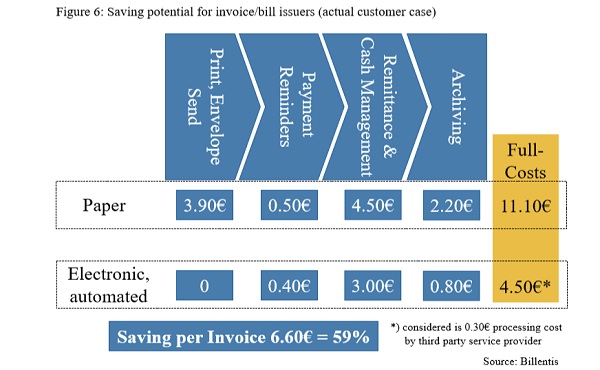How to save 59 percent on a key cost using e-invoicing
16th November, 2017

Ever wondered how much old-school invoicing costs your business?
If you’re still sending paper invoices, you need to print invoices, put them in an envelope, pay for postage and physically post them.
Then you need to do the same with payment reminders.
Then you need to manage the payment when it comes in, and archive it appropriately.
If you receive paper invoices, you need to: open the envelope, codify the invoice, validate it, match it in your software, manage any issues or disputes, and then archive it appropriately.
You get the idea: it’s labour-intensive and cost-heavy.
Direct (printing, postage, etc) and indirect (staff, time, etc) costs add up.
How can your business save some much-needed cash and free you and your staff up to move away from admin tasks and work on making money?
Switch to e-invoicing.
The magic numbers
We know that switching to e-invoicing solutions like MYOB PayDirect Online delivers savings for our customers.
But with more businesses now making the switch, we’re starting to see — in data-backed numbers — just how much of an impact it’s making.
Europe-based Billentis has used case studies in Germany [PDF] to put some meat on the bones.
Billentis started by breaking down all the costs associated with paper invoicing against e-invoicing.
It then attached a monetary amount to all the activities associated with the tasks above, using a company with 5000 employees on an average wage of 60 euros per hour.
For the invoice issuer, it calculated that they could save a whopping 59 percent on the costs of each invoice sent out.
For those receiving paper invoices, the saving is higher: 64 percent per invoice.
While these aren’t direct cash savings, they’re an indication of just how much time and labour you can save by switching to a paperless invoicing solution.
The cost of covering a cash-flow gap
But — and here’s the kicker — the biggest business costs and stress come up when you need to cover a cash flow gap when getting paid late.
A cash flow gap happens when you know you have some money coming in, but you need to pay your own bills with money that’s not actually in your account yet.
One solution could be using overdraft facilities to cover the gap.
The problem with that, of course, is that there’s associated interest.
Here are the sums:
Let’s say you invoice for $1000.
You get word that the client will pay you in 60 days, but you need the money in your account now.
So you go to the bank and get that cash into your account.
While you have $1000 in your account, at an interest rate of about 0.1 percent of the invoice value per day, that $1000 will in fact cost you $1060.
If your margin on the $1000 product or service is $200, you’ve essentially lost a third of your margin.
That’s a killer.
How to get paid three times faster
MYOB PayDirect Online users get paid, on average, three times faster* than people using paper invoicing.
That’s because it’s so much easier for your customers to open the invoice at their computer and hit “Pay Now” to take care of it straight away.
Speed of payment is absolutely crucial, because it turns out that cash flow is one of the major headaches suffered by small businesses.
In fact, a heck of a lot go out of business altogether because they can’t bridge cash-flow gaps.
In the example above, you’d be losing 6 percent of the real value of your product or service to make sure you have the money in your account.
But if you’re paid three times faster, you may even avoid the need for an overdraft altogether.
Whether it’s by making your processes less efficient or spending interest money on servicing a cash-flow shortfall, paper invoicing is becoming more and more costly.
E-invoicing solutions like MYOB PayDirect Online are saving customers both time and money **.
* Based on data for invoices paid using PayDirect Online between Jul 2016 and May 2017
**Even taking third-party transaction fees into account.
